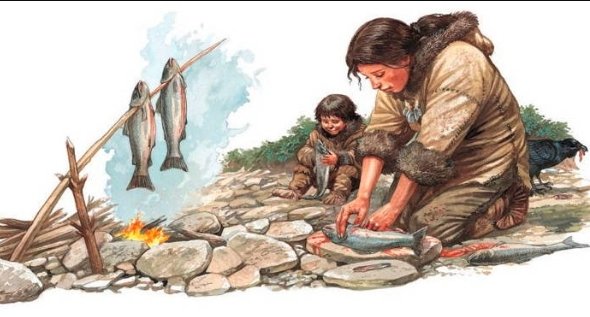Recent studies have shed new light on the dietary habits of Neolithic humans, revealing a more diverse and fish-heavy diet than previously thought. The Neolithic period, which began around 12,000 years ago, marked a significant shift in human lifestyle from nomadic hunting and gathering to settled farming communities. This transition brought about changes in food production and consumption, leading to a diet that included domesticated plants and animals. However, new research indicates that fish played a much larger role in the Neolithic diet than was once believed.
The Role of Fish in Neolithic Diets
Recent archaeological findings have uncovered evidence that Neolithic communities, particularly those near the Danube River in southeastern Europe, consumed significant amounts of fish. Analysis of pottery shards from this region revealed residues of fish oils, suggesting that fish was a staple in their diet. This discovery challenges the long-held belief that Neolithic diets were primarily based on terrestrial resources like meat and dairy.
The presence of fish in the diet of these early farmers indicates a continued reliance on aquatic resources, even as agriculture became more established. This adaptation may have been influenced by the availability of fish in nearby rivers and lakes, providing a reliable source of protein. The integration of fish into their diet highlights the flexibility and resourcefulness of Neolithic communities in their quest for sustenance.

Furthermore, the consumption of fish would have provided essential nutrients, such as omega-3 fatty acids, which are crucial for brain development and overall health. This dietary diversity likely contributed to the resilience and success of Neolithic populations, enabling them to thrive in various environments.
Agricultural Innovations and Dietary Shifts
The Neolithic period is often associated with the advent of agriculture, which brought about significant changes in human diets. The domestication of plants like wheat, barley, and lentils allowed for more stable food supplies and the development of permanent settlements. Alongside these crops, Neolithic farmers also domesticated animals such as sheep, cattle, pigs, and goats, which provided meat, milk, and other resources.
These agricultural innovations led to a shift from a predominantly hunter-gatherer diet to one that included a mix of cultivated and wild foods. The ability to grow and store surplus food enabled Neolithic communities to support larger populations and develop more complex social structures. However, the reliance on agriculture also introduced new challenges, such as the need for effective farming techniques and the management of food resources.
Despite the emphasis on farming, the inclusion of fish in the Neolithic diet suggests that these early communities maintained a diverse and adaptable approach to food procurement. This flexibility would have been essential in ensuring food security and mitigating the risks associated with crop failures or other environmental changes.
Insights from Archaeological Discoveries
Archaeological research continues to provide valuable insights into the dietary practices of Neolithic humans. The analysis of pottery shards, bone remains, and other artifacts has revealed a wealth of information about the foods consumed by these early communities. For example, the discovery of fish residues in pottery from the Danube region has prompted a reevaluation of the role of aquatic resources in Neolithic diets.
These findings underscore the importance of interdisciplinary research in understanding the complexities of ancient diets. By combining archaeological evidence with modern scientific techniques, researchers can reconstruct the dietary habits of past populations and gain a deeper appreciation for their adaptability and ingenuity.
The study of Neolithic diets also highlights the interconnectedness of human societies and their environments. The choices made by Neolithic communities in terms of food production and consumption were influenced by a range of factors, including geography, climate, and cultural practices. Understanding these dynamics can provide valuable lessons for contemporary food systems and sustainability efforts.













